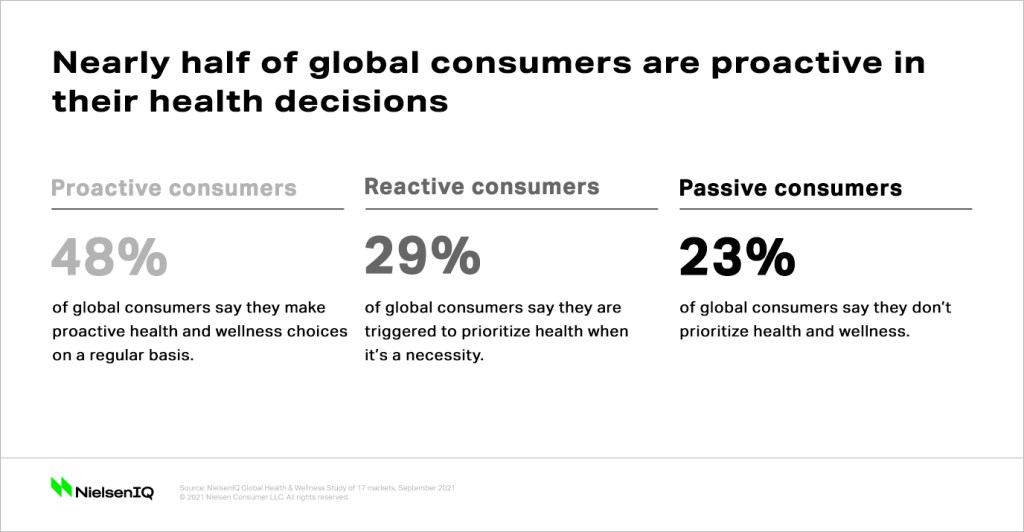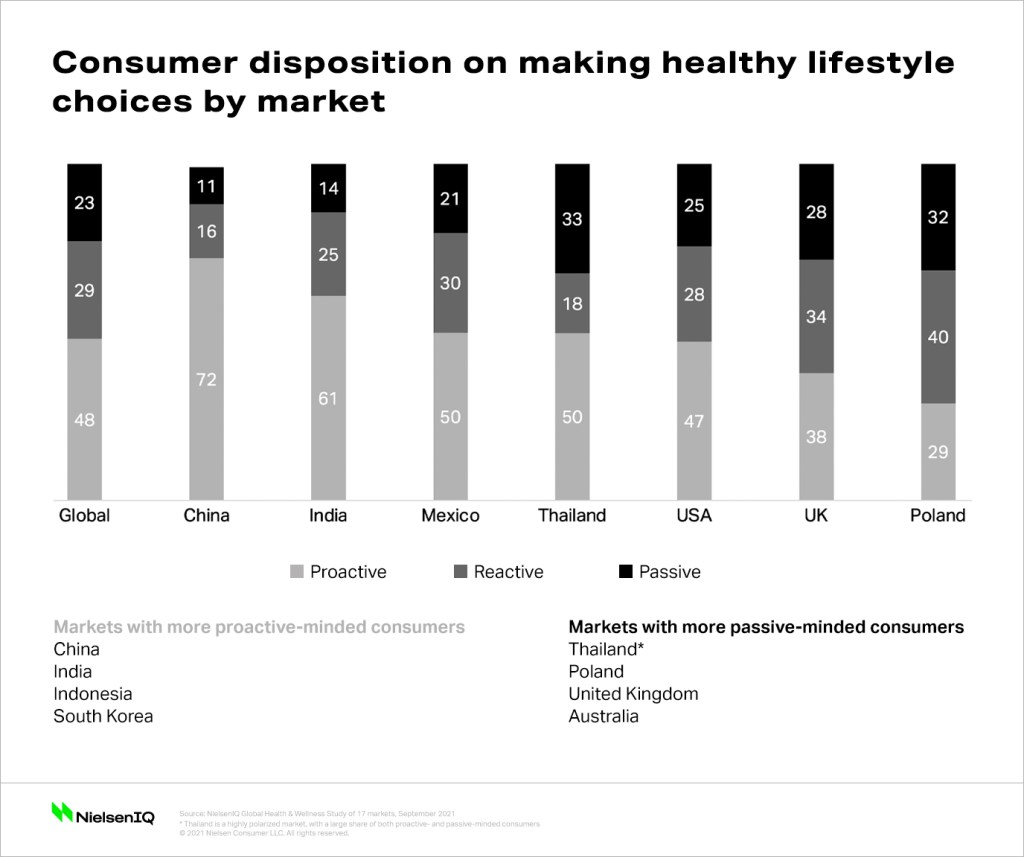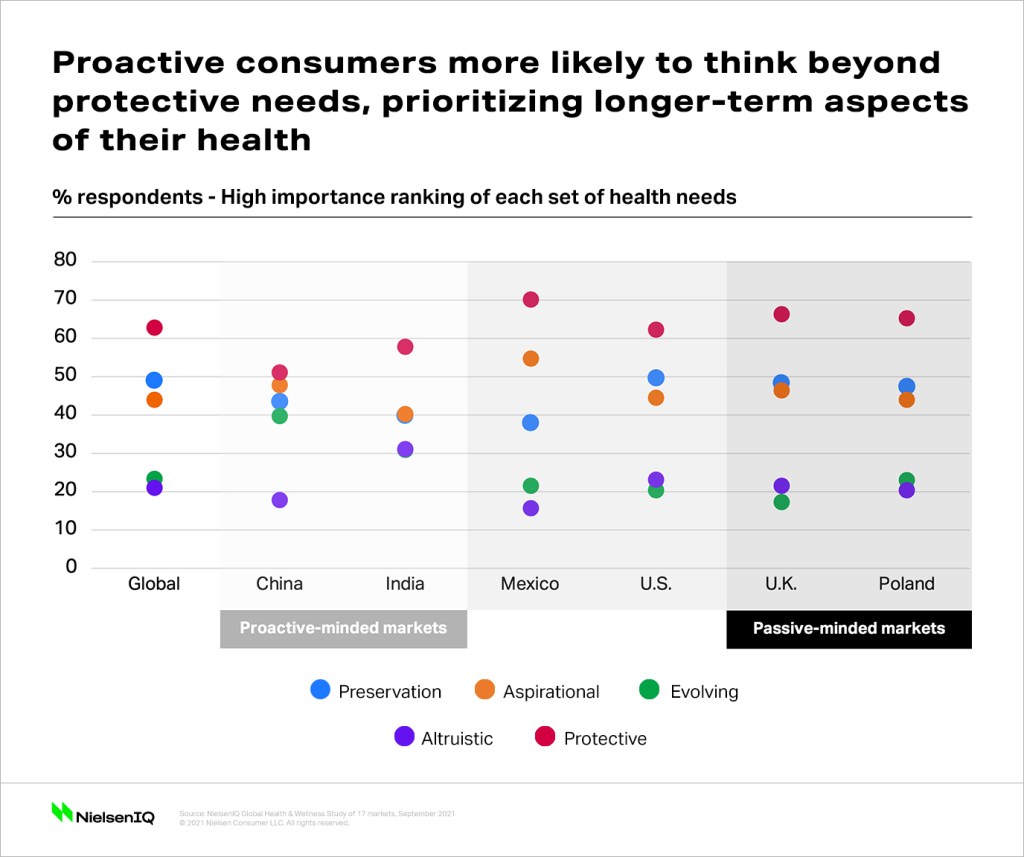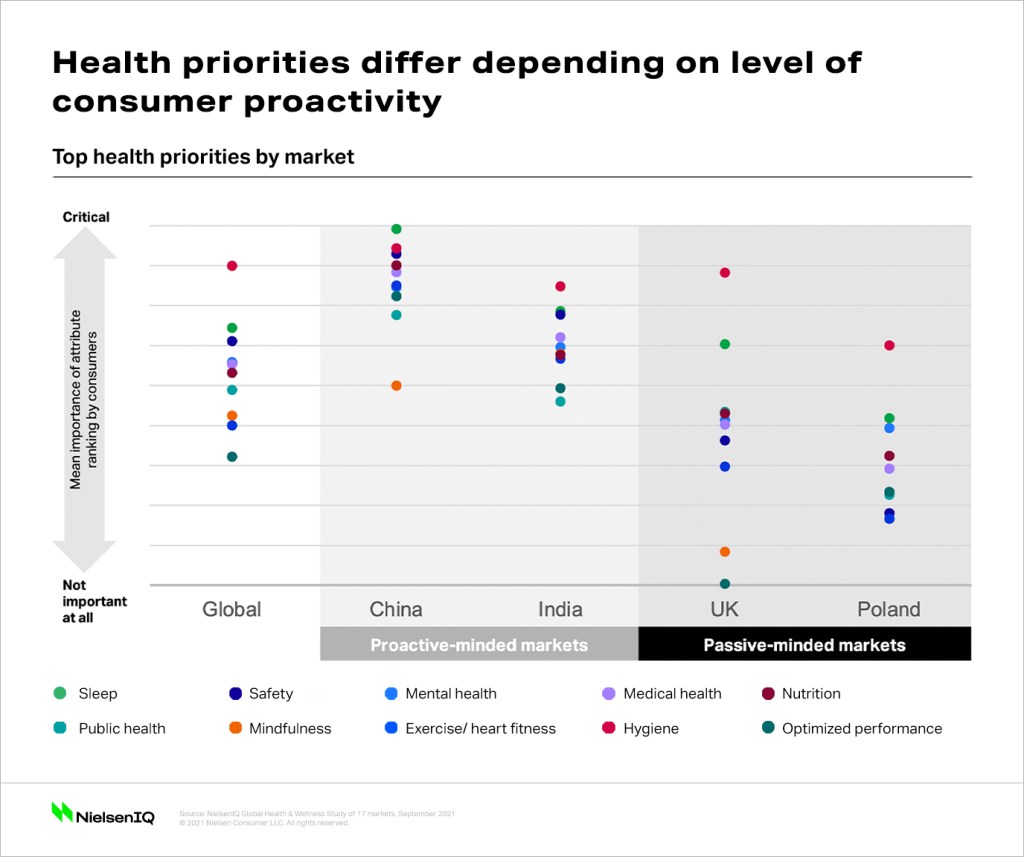Global divide in consumer disposition to healthy living
NielsenIQ’s recent global study on health and wellness segmented survey respondents according to their personal tendencies for health management. The resulting data pointed to a compelling distinction around how consumers approach health-related decision-making. According to the study, nearly half of global consumers are proactive in their health decisions, while the rest of the world tends to take a more reactive or passive approach.
As the world continues to slowly open, we see signs of formal pandemic policies shifting to endemic practices and consumers beginning to embrace their own moving-on mindsets. Global consumers are now being intentional in their pursuit of a health and wellness journey aligned with their individual comfort zone and style of decision-making.

Consumer tendencies differ by market
Understanding how different health-conscious consumer groups employ a proactive, reactive, or passive health disposition, and what motivates their approach, is crucial to making effective decisions in the health and wellness space. When looking at the data at a country level, it’s interesting to note which markets have the highest concentration of consumers who are willing to prioritize preventative and proactive health actions.

NIQ data shows that consumers in China and India are the most proactive among the 17 markets surveyed, and consumers in Thailand and Poland are the most passive in their approach to health management. In general, populations of proactively minded health-conscious consumers will likely need less intervention or regulation than those where consumers are more passive in their choice tendencies. This may perhaps lead to lower costs of sick care if ailments are managed proactively by a larger majority in a given country. Understanding the current landscape of engagement will provide useful visibility into where additional efforts, investment and motivation will be needed to foster consumer connections.
Impact to consumers’ hierarchy of health needs
As reviewed in NielsenIQ’s Global Health & Wellness Report, consumers varying health and wellness needs can be grouped into five key areas of priority:
- Protective needs: Focused on urgent desires for safety and protection from immediate health threats.
- Preservation needs: Focused on the broad spectrum of self-care, improving current physical or emotional wellbeing and connections.
- Aspirational needs: Focused on preventative care and taking proactive actions to achieve and maintain specific health goals, or helping to avoid ailments in the long-term.
- Evolving needs: Focused on innovative care solutions and seeking out the latest alternatives or developments to continuously meet health and wellness goals.
- Altruistic needs: Focused on selfless care and improving the world around us by advocating for environmental, ethical, humanitarian, and/or philanthropic causes.
While there are commonalities in how consumers around the world approach healthy living, there are unique differences in the order to which consumers are prioritizing their health needs in different markets.

Surveyed global consumers were asked to rank their personal hierarchy of health and wellness needs, spanning those that are protective, preservation-focused, aspirational, evolving and altruistic in nature. In this assessment, some common themes emerged. Universally, global respondents seem to agree that protective needs, such as hygiene and safety, rank as their top priority. However, looking at relative importance scores, protective needs tend to be more important for passive-minded consumers, while aspirational needs are more top of mind for proactive consumers who are trying to achieve long-term health goals and take preventative action to avoid disease. These findings highlight the level of nurturing that may be needed to convince reactive or passive consumers to engage in healthcare regimes that extend beyond immediate or personal needs.
Nuances of proactive and preventative approaches to healthy living
It’s no surprise that protective needs form the baseline to the world’s current hierarchy of health needs. Looking across individual health factors listed below, hygiene is ranked of critical importance among both proactive and passive-minded consumers across analyzed countries.

But beyond the basic and essential health priority of hygiene, we start to see variance in what else ranks as most important in a given country. In China, for example, sleep, nutrition, and medical health are preventative priorities aligned to the strong presence of proactive consumers measured there. By contrast, the U.K. has a larger body of passive-minded consumers when it comes to healthy decision-making. So, as expected, we see a relatively lower importance score associated with various health priorities.
The key to increasing the baseline of health living in our society rests in understanding what is important to each consumer segment. Future success will be defined by addressing specific health concerns in the right ways, aligning how consumers are willing to digest and prioritize personally relevant solutions.
How to influence healthier choices
Today, passive-minded consumers may be focused primarily on immediate or short-term health needs. But companies should strive to bring their interests and spending power through higher echelons of the hierarchy of health needs. Proactive consumers, on the other hand, are a present opportunity that should be pursued, now. These consumers are already interested in and prioritizing their aspirational, evolving, and altruistic health needs. They are investing in their long-term health, exploring new and innovative wellness regimes, and ultimately seeking to improve the health of others in addition to themselves.
When it comes to the varied dispositions of health-minded consumers around the world, there are unique opportunities in each country to both nurture the proactive and inspire the reactive or passive decision-makers. In order to drive long-term success, strive to activate consumer spending across all levels of the consumer hierarchy of health needs.
Stay ahead by staying in the loop
Don’t miss the latest NIQ intelligence—get The IQ Brief in your inbox.
By clicking on sign up, you agree to our privacy statement and terms of use.




